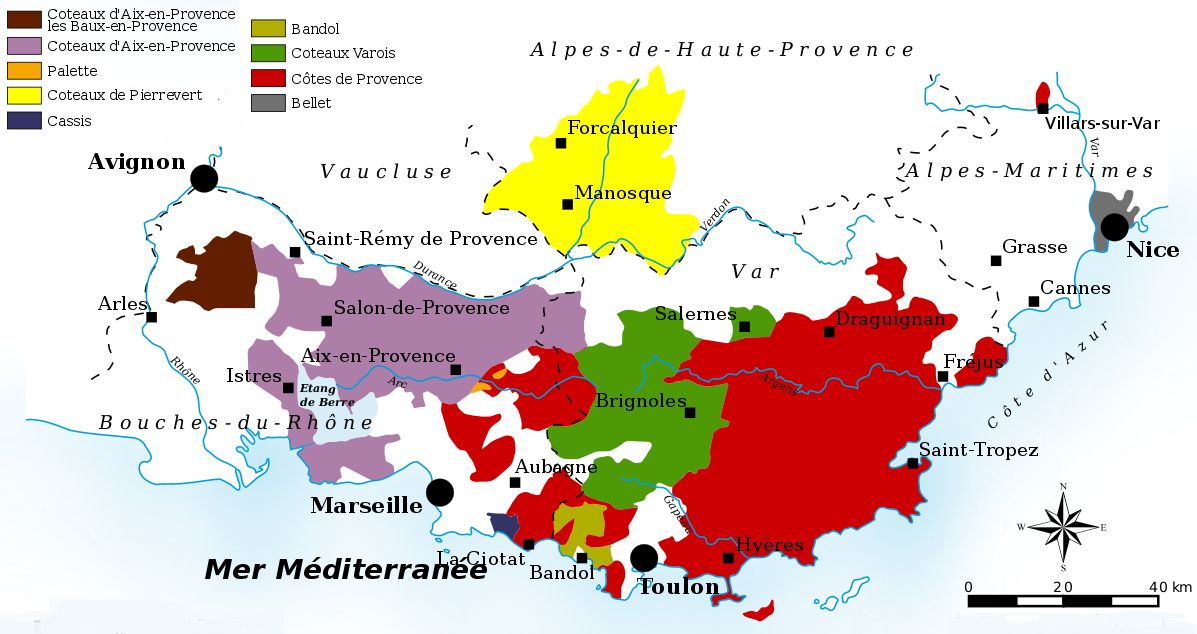Results
2,284 Results
Loading more Results ...
Loading more Results ...
Wine regions in Provence 12 growing regions
Description to Provence
The wine-growing region is located in the south-east corner of France and stretches along the Côte d'Azur from Marseille in the west to Nice in the east. It is bordered by the two major wine-growing regions of Languedoc in the west and Rhône in the north. Many sources consider the island of Corsica, 160 kilometres south-east of the coast, to be a common wine-growing area with Provence. In fact, there are many similarities. Together with the Languedoc-Roussillon region, Provence is often referred to as the Midi. Provence is one of the oldest wine-growing regions in France and Europe, as vines were planted and wine pressed here by the Greeks as early as the 6th century BC.
However, it is possible that the Celts (Gauls) were already doing this before them. The name comes from the Romans, who founded the "Provincia Romana" in 154 BC and supplied wine to Rome from here. Legionnaires who had been discharged from service received a small estate here as a reward, which they used for viticulture. The area has been hotly contested throughout history and belonged successively to the Roman Empire, the Frankish Empire, the Kingdom of Burgundy, the Spanish County of Barcelona-Arágon, the House of Anjou, the Kingdom of Sardinia and finally France.

The Mediterranean climate is characterised by mild winters, humid springs, hot summers and long, sunny autumns. In spring and autumn, the humid Marin sea wind blows from the south-east, bringing heavy rainfall. In the 19th century, large areas were destroyed by phylloxera. Today, the vineyards cover around 25,000 hectares of vines. The Côtes de Provence appellation in the east is by far the largest area, covering around four-fifths of the area.
As is usual in the south of France, numerous varieties are authorised, including many autochthonous vines, some of which are threatened with extinction. The most important red wine varieties are Barbaroux, Cabernet Sauvignon, Calitor Noir, Carignan Noir, Cinsaut, Grenache Noir (Garnacha Tinta), Mourvèdre (Monastrell), Rolle (Vermentino), Syrah and Tibouren, while the most important white wine varieties are Clairette, Grenache Blanc (Garnacha Blanca), Sémillon and Ugni Blanc (Trebbiano Toscano). Around half of the production consists of rosé wines, around 40% of red wines and 10% of white wines.
- Alpes-de-Haute-Provence (IGP)
- Bandol (AOP)
- Bellet (AOP)
- Cassis (AOP)
- Coteaux d'Aix-en-Provence (AOP)
- Coteaux de Pierrevert (AOP)
- Coteaux Varois en Provence (AOP)
- Côtes de Provence (AOP)
- Les Baux-de-Provence (AOP)
- Maures (IGP)
- Méditerranée (IGP)
- Mont-Caume (IGP)
- Palette (AOP)
- Principauté d'Orange (IGP)
- Var (IGP)
- Vaucluse (IGP)
Map: From DalGobboM¿!i? - Own work, GFDL, Link
edited by Norbert F. J. Tischelmayer 2/2018
Classified wine producers in Provence 9
find+buy for Provence 48
Recent wines 112
 Domaine Hauvette
— Provence
2017 Alpilles IGP "Dolia"
Up to 50.00 €
Domaine Hauvette
— Provence
2017 Alpilles IGP "Dolia"
Up to 50.00 €

 Domaines Ott
— Provence
2021 Côtes de Provence AOC "By.Ott"
Domaines Ott
— Provence
2021 Côtes de Provence AOC "By.Ott"

The most important grape varieties
More information in the magazine
- Plaimont - The vine rescuers from south-west France Advertisement
- Good Bordeaux doesn't have to be expensive! Crus Bourgeois
- Paradisiacal times! Tasting: European sparkling wines for the festive season
- Liv-ex classification: The fine wine market 2023 France is the measure of all things
- Domaine Combier Collection of the Year 2022 - Rhône
- The collections and discoveries of the year 2022/2023 tasting season
- Social responsibility in the name of wine In Focus: Vignerons Engagés
- AB, Vignerons Engagés, HVE, Terra Vitis: what are the differences? Organic certifications for French wine
- A lot of power for little money In Focus: Côtes du Rhône Villages Rouge
- Saving your account with pleasure In Focus: Crozes-Hermitage

